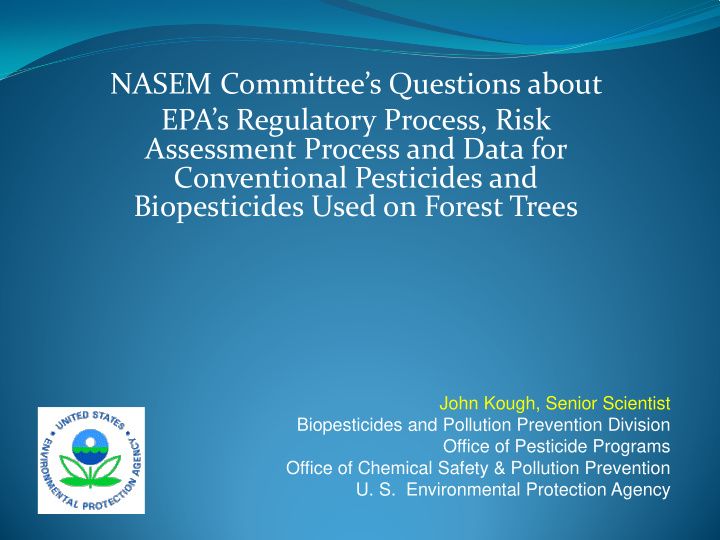



NASEM Committee’s Questions about EPA’s Regulatory Process, Risk Assessment Process and Data for Conventional Pesticides and Biopesticides Used on Forest Trees John Kough, Senior Scientist Biopesticides and Pollution Prevention Division Office of Pesticide Programs Office of Chemical Safety & Pollution Prevention U. S. Environmental Protection Agency
Agenda Legal and regulatory process? Risk assessment process? What data is required and how is it different (or the same) as with conventional pesticides and biopesticides used in an agricultural crop setting? 2
Laws & Regulations Federal Insecticide, Fungicide, & Rodenticide Act: Registration of Pesticide Active Ingredients & Products Federal Food Drug & Cosmetic Act: Determination of Safety of Pesticide Residues in Food and Aggregate Exposure Pesticide Registration Improvement Act: Provides Fee for Service and Decision Timelines 3
Pesticide Definitions Conventional Pesticides A pesticide is a substance or mixture intended to prevent, destroy, repel or mitigate any pest or intended for use as a plant regulator, defoliant or desiccant. 40CFR 152.3 4
Pesticide Definitions Biopesticides A Biochemical pesticide is a naturally-occurring substance with a history of exposure to humans and the environment demonstrating minimal toxicity and with a non-toxic mode of action to the target pest. 40CFR 158.2000 A Microbial pesticide is a microbial agent intended for preventing, destroying, repelling or mitigating any pest and is a eukaryotic microorganism (protozoa, algae or fungus) a prokaryotic microorganism or a virus. 40CFR 158.2100 5
SAFETY STANDARDS FIFRA: No unreasonable adverse effects from use of the pesticide on the environment FFDCA: Reasonable certainty of no harm to aggregate exposure of pesticide residues 6
How Does EPA Assess Risk? Follow the National Academy of Sciences (NAS) four-step risk assessment paradigm*: *From the National Research Council’s Risk Assessment in the Federal Government: Managing the Process, 1983. 7
DATA REQUIREMENTS FOR CONVENTIONAL PESTICIDES 40 CFR part 158 subparts D, F, and G cover a complete suite of tests typically submitted for pesticide active ingredients (AIs) Hazard Identification and Dose Response: AIs proposed for use on food require extensive toxicology tests for acute, subchronic, and chronic toxicity, including developmental and reproductive effects, carcinogenicity, neurotoxicity, and immunotoxicity Ecological effects cover surrogate species for aquatic, terrestrial and honeybees AIs also require data to estimate exposure – crop residues, environmental fate 8
Data Requirements Conventional Pesticides Ecological Assessment based on Pesticide Guidelines (40CFR158 subparts G & N) Hazard Consideration for Non-Target Organisms: Surrogate Species to Account for Expected Exposures Acute, Dietary, Reproduction; Avian, Fish, Invertebrates, Honeybee Plants; Seedling Emergence, Vegetative Vigor Environmental Fate in Various Media to Address Persistence Degradation, Metabolism, Mobility 9
Data Requirements Biochemical Pesticides Ecological Assessment based on Pesticide Guidelines (40CFR 158 subpart U) Tiered testing scheme: Adverse effects in lower tiers trigger more testing in higher tiers Hazard Consideration for Non-Target Organisms: Fewer Surrogate Species based on Existing Exposure Avian, Fish, Invertebrate, Honeybee Environmental Fate in Higher Tiers 10
Data Requirements Microbial Pesticides Ecological Assessment based on Pesticide Guidelines (40CFR 158 subpart V) Tiered testing scheme: Adverse effects in lower tiers trigger more testing in higher tiers Hazard Consideration for Non-Target Organisms: Fewer Surrogate Species based on Existing Exposure Pathogenicity to Non-Targets Avian, Fish, Invertebrate, Insects & Honeybee Environmental Fate in Higher Tiers 11
Questions or Clarifications 12
Recommend
More recommend